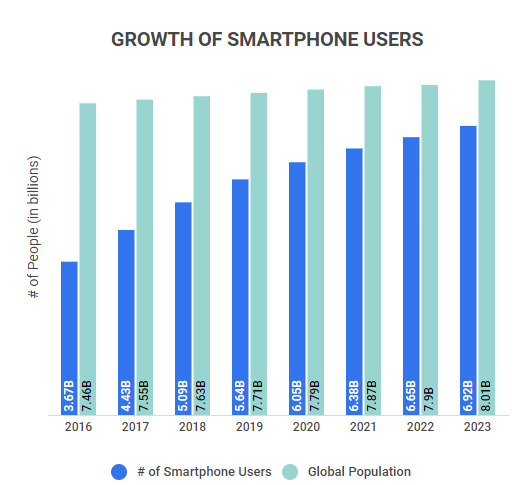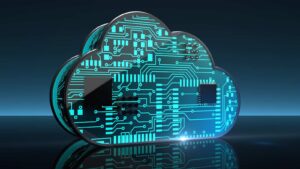Mobile distributed computing on the blockchain is the future. As we stride into 2024, the exponential growth in smartphone adoption continues to be a testament to technology’s pervasive influence on modern society. The statistics from recent years have been staggering, with the number of smartphone users globally not just paralleling but in many instances surpassing population growth. The provided chart illustrates this phenomenon with striking clarity: by 2023, the number of smartphone users will reach an astounding 6.218 billion, showcasing not only a significant penetration rate but also the possibility that many individuals now possess multiple devices.
Table of Contents
ToggleSmartphones as Nodes in the Future of Distributed Computing
The relentless increase in users – a trend that saw a consistent annual rise even when compared against the global population – underlines the profound impact of competition among smartphone manufacturers and the ever-expanding availability of the internet. The year 2023 was a landmark in this trajectory, with smartphone technology not just serving communication needs but becoming central to numerous aspects of daily life. Processing power, an essential attribute of these devices, saw considerable advancements, leading to smartphones being reimagined as not just tools for personal productivity but as potential nodes in a distributed computing system.
Global Usage of Smartphones
This chart underscores the potential for mobile distributed computing on the blockchain, where each smartphone acts as a computational unit within a larger, decentralized network.

By harnessing the power of millions of such devices, we can envision a new architecture that executes complex tasks, including machine learning models, on a scale previously unimaginable. The implications of this growth trend extend beyond mere numbers; they suggest a paradigm shift towards a more distributed, democratized, and accessible computing infrastructure. With the robust increase in smartphone users as shown in 2023, we stand on the brink of a technological revolution that could redefine the boundaries of distributed computing.
Evolution of Processing Power in Smartphones
Smartphones are no longer mere communication devices; they are powerful computing gadgets. The continuous enhancements in processing power, memory, and storage capacity make them viable contenders against traditional PCs and even gaming consoles like PlayStation and Xbox. The expected surge in IP traffic and the diversification of services, especially in the 5G era, hint at an exponential growth in the capabilities of these devices. This evolution sets the stage for smartphones to be more than just personal devices; they can be nodes in a vast, distributed computing network.
The Role of Machine Learning in Distributed Computing
Machine learning, inherently computational, relies on large data sets for training models. As data sets grow, so does the need for computational power. Distributed computing offers a solution by partitioning data across multiple machines or nodes. These nodes perform computations locally and coordinate to compute the desired outcomes, a practice standard in large tech companies dealing with massive data sets. The concept of a computer cluster, a set of loosely or tightly connected computers working as a single system, is pivotal in this setup. The synergy between hardware and software is crucial in creating an efficient distributed system, with platforms like Apache Spark playing a key role in processing large-scale data efficiently.
Distributed Computing on Smartphones
Smartphones have evolved to handle complex computational processes. Operating systems like Android and iOS have been instrumental in this evolution. Applications on smartphones are becoming increasingly sophisticated, offering a range of services from messaging to online shopping. However, these applications have not fully utilized the computational potential of smartphones, especially in machine learning processes. This paper proposes a new architecture for a distributed computing system that harnesses the computational power of a network of smartphones. This network collaborates to execute and train machine learning models, presenting a novel approach to distributed computing.
Challenges and Limitations in Mobile Distributed Computing
While the concept of mobile distributed computing is promising, it is not without challenges. Data normalization is crucial to ensure the accuracy of predictions across different nodes in the network. Different operating systems in smartphones may impose restrictions on resource usage, potentially limiting the scope of distributed computing. Furthermore, the suitability of different machine learning algorithms for a distributed system varies, with some algorithms requiring instant feedback within the processing unit, posing a challenge for implementation.
Conclusion and Future Directions
The exponential growth in smartphone capabilities and features presents a unique opportunity to harness these devices for more than personal use. The proposed architecture aims to allow users to monetize their smartphones by contributing their processing power to a network that executes and trains machine learning models. This paper has laid the groundwork for this concept, using technologies like the Ionic framework, JS-Regression, and Firebase’s NoSQL database. Future work will explore extending this implementation to IoT systems, potentially revolutionizing the way we process and utilize data in a distributed manner. The concept of ‘Edge computing’ and ‘Edge learning’ will also be pivotal in leveraging the processing power of individual network nodes, reducing reliance on centralized cloud servers, and paving the way for a more efficient, decentralized computing landscape.
Read more:





